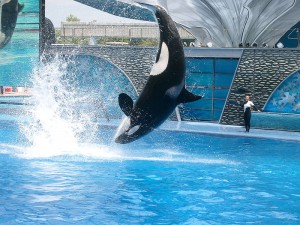
Photo credit: Christopher Down
Now it’s time to tackle the issue of captivity and I must say I do so reluctantly. Because when it comes to marine mammals in captivity, there are lots of opinions and no easy answers.
To ease into the subject, the Encyclopedia of Marine Mammals begins with a mini historical overview of marine mammals in captivity. “Polar bears were kept by Scandinavian rulers prior to the Middle Ages; a killer whale that had been live stranded was kept and used for sport by Roman guards during the first century AD; and seals were kept in menageries by the eighteenth century.” All very interesting.
But things really took off for captivity in the 1950s, 60s and 70s. Fueled by popular demand, the number of SeaWorld like places increased and many zoos rushed to display marine mammals too. The television show “Flipper” also helped to generate more interest in seeing friendly dolphins in person. (For those interested in learning more, The Cove is an excellent documentary on some of the devastating repercussions of the Flipper / captivity aftermath.)
That is all in the past, the question remains what do we do now? The fact is that the SeaWorlds of the world and institutions like them are here to stay as long as people are still buying tickets. And it’s unfair to say that captivity is all bad. Many researchers and scientists have been inspired to pursue their chosen marine mammal fields after seeing dolphins, killer whales or sea lions in captivity. Opportunities to see marine mammals in captivity have also led to greater public awareness and scientific understanding of dolphins and killer whales.
So does that mean that some animals have to pay the price of captivity to ensure that humans appreciate them and make an effort to prevent the degradation of their natural habitat? Well, if that’s the strategy, the Encyclopedia of Marine Mammals points out that it doesn’t really work that way in practice. While “public support for marine mammal conservation increased substantially in the latter half of the twentieth century. It is also clear that marine environmental degradation, particularly through overfishing, also increased substantially at the same time.”
Some suggest that whale watching is a better alternative to seeing marine mammals in captivity. But based on surveys, “nearly 80% of respondents to the survey…had been to a zoo or an aquarium in the previous 5 years, but less than 20% had been whale watching over the same period.” Plus, whale watching is only a realistic option for people living along the coast or for people who have the income to travel to the coast and actually make time to go whale watching assuming that the weather and whales’ migratory schedules permit viewing.
Like I said at the beginning, there are no easy answers. It’s so hard to get people to appreciate anything outside of themselves. And since the marine mammal “ambassadors” are already working full-time to represent their species, it seems like the best compromise is to stop taking any new animals from the wild and use captive breeding techniques to keep the ambassador program going in the hopes that it continues to inspire future generations to practice marine conservation.
Of course, it would be difficult to enforce countries around the world to stop taking new animals from the wild since there is no strong international organization keeping watch over our oceans. According to the Encyclopedia of Marine Mammals, developing nations are really the only countries still capturing marine mammals. Let’s just hope that they start implementing strict regulations like the U.S. has to ensure marine mammals live in the best conditions possible.
And after the recent tragedy of the trainer killed by Tillikum at SeaWorld it’s time to take a second look at whether killer whales belong in captivity. Orcas are six ton animals and it’s logistically impossible to provide them with the space they need to maintain their mental and physical health. It may be best to stop keeping killer whales in captivity and leave the much smaller dolphins and sea lions to spread the good word on behalf of marine mammals everywhere until humans evolve to the point of being able to appreciate wildlife without having to see animals behind bars or within pools.
Great post, so much to think about. Thank you!
True many people have been inspired to pursue careers with marine mammals. But with the ever growing visual media today current and future scientists can just as easily watch and appreciate their favorite marine mammals on their TV, laptop, iPod . My life long love of the oceans was fostered by the Jacque Cousteau specials of the 1960s. Today I see no need for people to have to go “buy a ticket” in order to be inspired. Perhaps these research/ facilities could operate without selling tickets and training intelligent creatures tricks for our amusement. Then it wouldn’t appear they were just commercial enterprises exploiting non humans for profit.